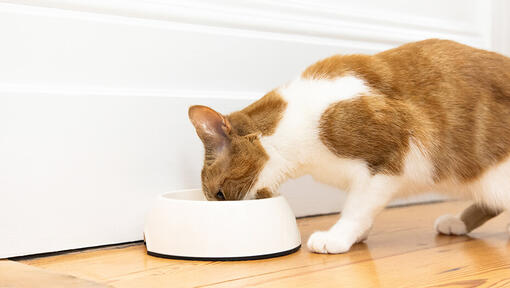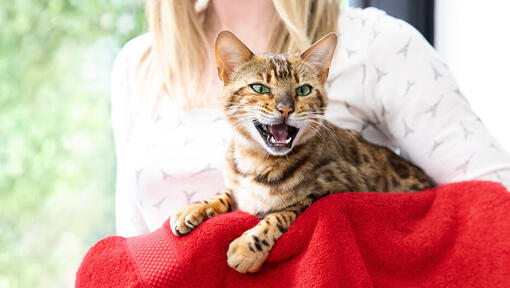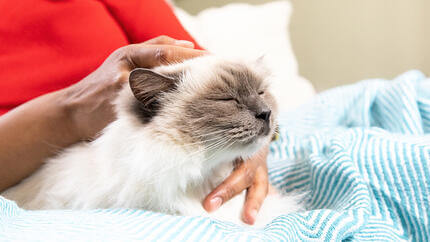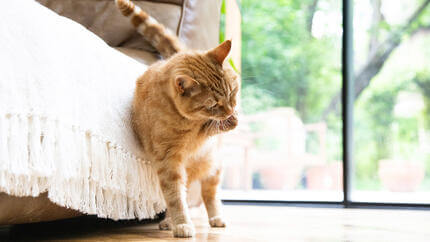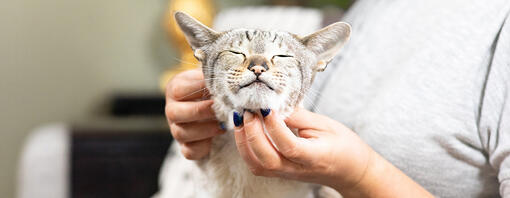
Getting a feline to do anything unwillingly is a challenge few owners look forward to. Here is a guide to how to give a cat a pill while minimising stress to you and your cat.
Giving a cat a pill is one of those tasks cat owners keep their fingers crossed they won’t have to do too often. But unfortunately, there are times when you need to give them important medication. It’s not as easy as it sounds: there are claws and teeth you need to stay clear of, and cats are experts at spitting out pills.
Before we get to our tips on how to give a cat a pill, the first thing you should do is check with your vet for any restrictions on how the medication should be administered. Certain pills can be mixed with food, while others must not be. Some pills can be crushed or divided, but others cannot as this could risk damaging your cat’s oesophagus or stomach. This is because the medication will no longer be protected by the outer coating of the pill. Knowing this information can help you decide on the best way to give your cat the tablet.
Once you’ve established what you can and can’t do with your cat’s medication, there are a few methods to get past those feline defences and give your cat the pill.
How to give a cat a pill
Here’s a step-by-step guide to administering medication to your cat by hand.
- Try to approach the task calmly, aiming to minimise stress to your cat. If you haven’t given a pill before, it is very useful to ask a vet or vet nurse to show you how to safely give oral medication. Do not put yourself at risk of getting bitten, and watch your cat closely for signs that they are becoming angry or distressed.
- Place your cat on a flat, stable surface such as the floor or a tabletop. It can be helpful to put down a towel to stop them from slipping.
- To give the pill, this will be easier from behind or next to your cat. However, avoid taking your cat by surprise as this will startle them and may result in a defensive scratch or nip.
- Having a second pair of hands can be very helpful, but is not essential. You want your cat to be facing away from you as this will make it easier to restrain their legs or any other movement they might use to try and escape your grasp. You may find it helpful to hold them securely against your body to prevent them from reversing.
- Take the pill in one hand and with the other hand gently hold over the top of their head with your thumb and index fingers on either side of their jaw and tilt your cat’s head upwards. Use the other hand to gently open the lower jaw to open their mouth.
- Use your index finger to place the pill in the middle of their tongue, as far back as you can.
- Close your cat’s mouth, gently rub their throat for a few seconds and then return their head to a normal position and wait for them to lick their lips as they swallow.
- Once you think your cat has swallowed, check their mouth and the corner of their lips if they will let you. If you can’t spot the pill, then you can be reasonably confident that you’ve been successful.
- If you see they haven’t actually swallowed it, just try to place it at the back of their tongue again, close their mouth and gently rub their throat. You could squirt a very small amount of water in their mouth to encourage them to swallow the tablet, but not too much as this may cause them to choke. In some cases, it’s best to let them spit it out completely and start the process again.
- The final step is to treat your cat with their favourite food and toys once they have ingested their medication. This helps to develop a positive association between receiving medication and having a treat, and can help to make the process a little easier in future.
Safety tips when giving a cat a tablet
- If your cat scratches or doesn’t like being held, try wrapping their body and legs in a towel, allowing only their head to remain exposed.
- Always hold over the top of their head to reduce the risk of being bitten.
- If your cat is particularly unruly, get another person to hold them while you administer the pill.
- If you or your cat are getting stressed, stop and give them a few treats and gently stroke and soothe them before trying again.
- If you get bitten by your cat, contact your GP for advice. Cat’s teeth harbour nasty bacteria which can cause an infection.
- When you get a new cat or kitten, you can try training with treats to get them used to having their mouth opened gently. Keeping up with regular training in this way can help to reduce stress if they need tablets later in life.
What to do when giving your cat a pill by hand fails
This device removes the need to place your fingers in the cat’s mouth, but can damage the back of their throat if used incorrectly. Only use a pill popper if you have been shown safe technique by a vet or vet nurse. Put the pill in the device and push down the plunger to release the tablet in their mouth. Try it first with a few treats to allow your cat to get used to the new delivery system.
If the vet advises that mixing the medication with food is possible, choose your cat’s favourite treat and sneak the pill in. Make sure the treats are small enough so that the cat won’t have to chew it. Give them their treat, followed by the pill itself and another treat. Avoid putting medication in your cat’s food bowl as you cannot be sure they will consume it. The tablet could dissolve over time, or be spat out. This also risks other household pets eating the meal and taking medication which is not prescribed for them and can be dangerous.
In cases where the pill can be combined with food, another way to deliver the medication is in powder form mixed in with a small portion of their usual diet or with a little water. Use a pill-crusher device to make sure the dosage stays the same and you won’t lose part of it in the process. Make certain that your cat is eating the food that contains the crushed medication, as otherwise you will need to try an alternative method. As discussed above, do not allow other household pets to consume medication that is not prescribed for them.
For cats that won’t accept a pill in any shape or form, some medication is also available in other forms such as oral liquids or veterinary injections. Unfortunately, some medications do not have good alternatives, but it always worth asking your vet what options are available.
Giving a cat a pill is a different experience with every individual. Some cats can be reasonably cooperative, while other felines will be much feistier. If your cat is the latter, make sure you keep calm and handle your cat gently.
Provide plenty of rewarding treats to encourage positive associations with the tablet feeding process. If you’re stuck for inspiration, here are a few snacks and treat ideas for your cat.
If your cat gets particularly upset and there is no way you can convince them to swallow the pill, contact the vet to let them know that your cat is not taking the medication. It is important that the vet practice is aware if a cat is not taking prescribed treatment. Depending on the underlying reason for the medication, it could cause a significant health problem if your cat does not take essential pills. A vet will be able to advise what alternatives are available, and whether a vet visit is needed.


